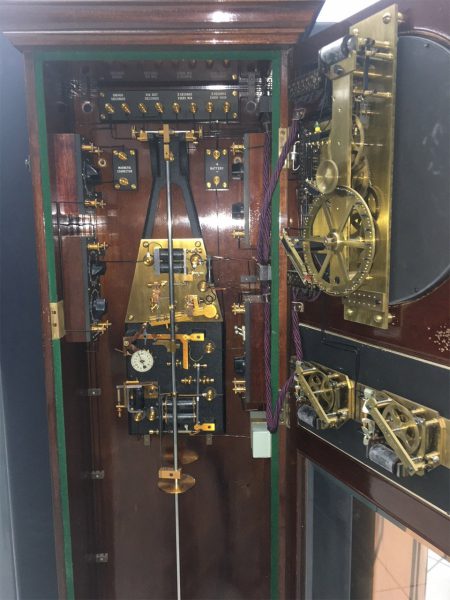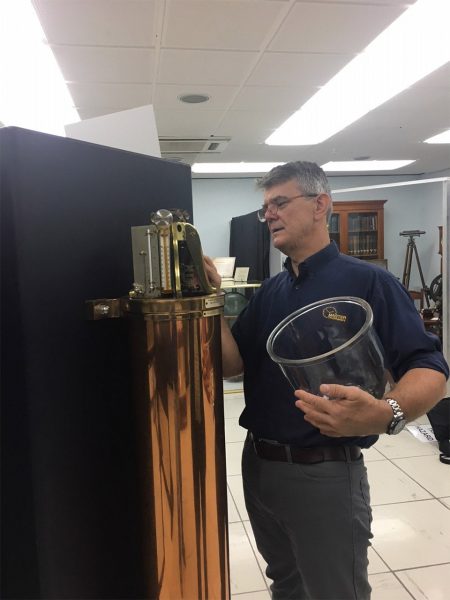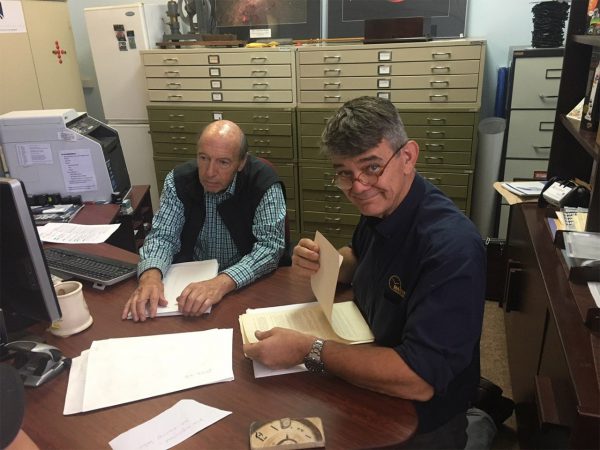
All observatories rely on accurate, precise timekeeping to guide their telescopes and to analyse data. Traditionally, observatories have also provided a time service for the community at large. Perth Observatory is no exception – from our earliest days, the observatory managed standard time for the Colony of Western Australia. We provided a time service for ships’ navigators at Fremantle, and for expeditions to the interior of the state. During World War II, Perth Observatory provided a time service for allied forces in south-east Asia and the Pacific.
Over the long history of the observatory, we have built up an impressive collection of chronometers, Kullberg mechanical clocks and – of course – our two Shortt Synchronomes. None of these clocks are in working condition at present, a fact which often disappoints our visitors. So our operations manager Francesca searched the known universe (well, Australia) to find a master of time capable of fixing our clocks. One name kept coming up – Andrew Markerink of Master Clockmakers in Sydney. Andrew has been responsible for the building and restoration of many public clocks including Sydney Town Hall, the Port Arthur Historic Site and the five-metre diameter Central Station clock in Sydney.
Andrew came over to Perth in February 2018 to inspect our clock collection, report on its condition, and provide an estimate to return the clocks to working order.
I think it’s fair to say that Andrew was surprised and delighted at the extent and quality of the collection. Several of the clocks are of outstanding quality and very significant historically.

Andrew was a most affable fellow and very happy to explain all the inner secrets to Mike Myers and myself. He also stayed on for the night sky tour.
We now have Andrew’s report and quote to repair or restore each of the clocks. In some cases, such as the Poole chronometer, the item has great historical importance but is in poor condition and not worth trying to restore. In this case, a minimal amount of repair has been recommended to stabilise the mechanism and prevent further deterioration.
On the other hand, the Kullberg and Shortt clocks could be fully restored and be working again. However their present environment on the false floor of the old computer room is not suitable, and a more solid foundation needs to be provided. This, in turn, means we need to consider redevelopment of the museum, which has been a long-term goal. Some quotes from the report are illuminating:
Kullberg astronomical clocks: “Very fine quality clock made by one of the finest clockmakers of the period… Without a doubt one of the best quality clocks that Kullberg would have made… This is a regulator of the very highest quality and is one of the best that could have been purchased from any maker in the world”.

Kullberg chronometer: “Of substantial value in its own right as this is a rare and important maker and clock style. This clock is in exceptional condition. Highly significant clock and an important part of the Kullberg collection… I would recommend that this piece not be put back into operational use as these clocks are easily damaged by inexperienced operators… the clock can be destroyed beyond viable restoration”.
Shortt: “Notwithstanding the incredible importance [of its] association with the Perth Observatory, this clock was originally in operation at the Royal Observatory at Greenwich. Both the Greenwich and Perth Observatory applications would make this particular Shortt clock one of the most important clocks of the only 100 ever built… The ability to have these clocks operating will provide the public with insight and understanding of the extraordinary system that the Shortt clocks use to provide such highly accurate timekeeping”.
Your committee is now considering Andrew’s report and will work up a strategy to implement the key recommendations





